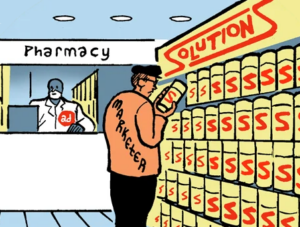Retail media is entering what might be called its Socratic phase.
The closer we to get to understanding an ad campaign’s real impact and business results, the clearer it is that we have no idea how this thing works.
That was the vibe at the IAB Connected Commerce event in New York City, at least.
Clean and clear
One promising development for retail media is the adoption of data clean rooms. In a clean room, a brand’s data, the retailer’s data and sometimes other data sets, like Google’s first-party data, can be incorporated into targeting and attribution for a single campaign.
The idea sounds great. But as you dig in, the transparency only reveals how little you saw before, like going from peeking through a keyhole to having a crack in the door.
For example, clean rooms are sold as a part of the real-time bidding process, as opposed to running incrementality or media mix modeling tests that might take many weeks to complete. But the data clean room feedback loop also turns out to have a serious latency issue, said Pacvue Chief Product Officer Sunava Dutta during one panel. The norm is for a clean room-based retail media campaign to update every week or so.
“How many of you would book a picnic a week in advanced based on the weather today?” Dutta asked, rhetorically. “None of you. We have [the same] latency problem with data clean rooms.”
Another major value prop of retail media and data clean rooms is that advertisers can input a desired business outcome, like a purchase, customer sign-up or foot traffic increase, rather than falling back on more proxy-based metrics like views and click-through rates.
That’s all well and good, but what advertisers are discovering is that even their inputted business metrics are still actually proxy metrics.
Too many ad vendors and agencies see themselves as “in the business of moving averages forward,” as put by Jared Belsky, CEO of the retail agency Acadia. They use an aggregate metric like ROAS, which can be jiggered to look great even if the business is doing poorly.
Now there’s an interest in retail marketing measurements beyond averaged-up metrics. “Could you look the CFO in the eye and say, ‘Here are two tests I’m running, and I can tell you whether there’s either more or less cash in the till at the end of the damn test,” Belsky asked.
Retail media has also revealed the degree to which the online ad industry relies on modeled data, said Abhi Jain, Instacart’s senior director, media analytics. In the medical and pharma industry, where getting things wrong really matters, “they don’t rely on modeling,” he said. They have to run the tests over and over, tracking each individual instance to its conclusion.
If a pharma brand’s test of a new drug doesn’t reach critical mass for a number of people in a study, say, they don’t fill out by modeling what they have against a Nielsen average or historical info.
Even optimizing a campaign based on actual online or in-store purchases, which sounds foolproof, could be a fool’s errand.
When an AI-based ad platform like Google, Amazon or Meta is instructed to optimize and target based on purchases, what that platform actually does is target ad impressions that allow the platform to self-attribute purchases to the campaign. Which is why Google Performance Max, for instance, will feast on Google Search terms for the brand’s own name and products, because those shoppers are about to make a purchase anyways.
The big platforms, as well as smaller retail media networks, are the major purveyors of MFA ads – garbage placements on cynical, scammy sites that deliver no real brand value. By tagging somebody with an ad on some cheap, meaningless URL, a platform like Amazon or Google can self-attribute any real conversions within a given attribution window, having paid next to nothing for that impression. Often, the retailer or a big platform with incredible data knows that a person, say, reups a particular purchase at a similar time every month, and thus can cost-effectively rack up attribution on sales that are actually organic to the brand.
Digital marketers rely on statistics. But are statistics reliable, if they lead advertisers to MFA placements and their own branded search terms?
Ram Singh, Horizon Commerce chief data and analytics officer, said this kind of “directionally right” thinking, where advertisers point and aim campaigns like playing pin the tail on the donkey, is still incorrect. But, he added, AI is a more effective recursive way to look back at a complete, understand what worked and what didn’t, and change the next time.
Sometimes, data can be directionally correct while still be entirely misleading, added Meghan Corroon, co-founder and CEO of the incrementality and measurement startup Clerdata. “When it gets crappy with statistics, it can get really crappy. The opposite of what you should do kind of crappy.”
The human problem
Data isn’t the only thing that can squirm and misdirect.
Advancements in retail media measurement have the uncomfortable effect of pitting marketers against themselves or other parts of the business org.
One of the challenges with incrementality measurement, according to Corroon, is that the data can often single out one person or part of the overall equation of a campaign. While MMM measurement might attribute media channels at an aggregate level, incrementality measurement might single out a particular creative element, or a particular media buyer.
All of a sudden, a very uncomfortable finger is pointing directly at somebody or a team whose work has been poorly credited.
“The human component of it,” she said, trailing off. “The math can’t solve that.”
Marketers can’t avoid the tough conversations. But they can still make their case.
“The best brands are already having those dialogues,” said Kimberly Sugden, head of retail media and ecommerce marketing for PepsiCo’s tea portfolio (they own the Lipton, Brisk and Pure Leaf brands).
Educating CFOs and general managers is particularly important, Sugden said. “Because maybe they’ve only seen results for search where it shows ROAS, and then they see a smaller ROAS number and think it’s worse. But it’s actually because it’s just different.”
Advertisers must accept the fact that the industry is early on in a period of rapid change.
“This is how we learnt to walk,” Singh said. “We fell; we tripped; we picked ourselves up; and then, eventually, we started walking.”
















